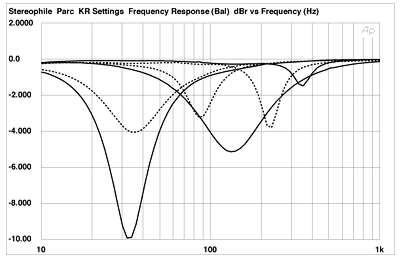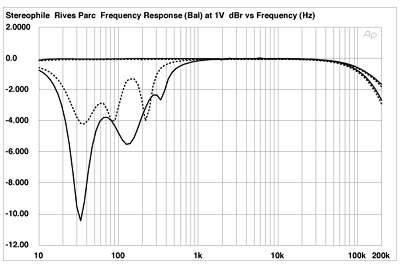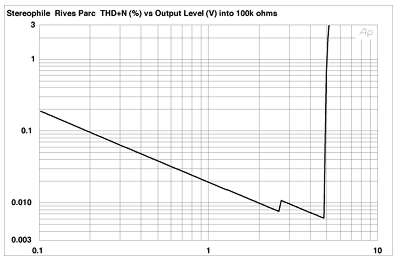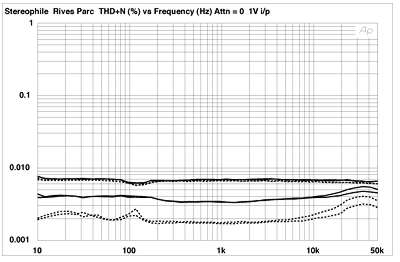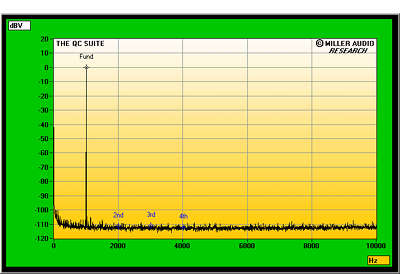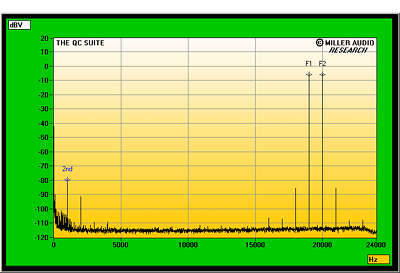Rives Audio PARC
Listed · 266 Views
This listing has ended.
Listings Similar to Rives Audio
Time Left: Listing Sold
This listing has ended.
| Condition | |
| Payment methods | |
| Ships from | Los Angeles, CA, 90077 |
| Ships to | United States and Canada |
| Package dimensions | unspecified |
| Shipping carrier | UPS |
| Shipping cost | Free |
| Original accessories | Box, Manual |
| Research Pricing |
Rives Audio Parc Subwoofer parametric EQ..............
ROOM TREATMENT REVIEWS
Rives Audio PARC 3-Band Parametric Equalizer
Kalman Rubinson | Jul 20, 2003
Last January, the Stereophile website conducted a poll asking readers what they thought was their audio system's weakest link . The results indicated that 24% thought that their room was the most problematic component. What this says is that, though often accused of being obsessed with hardware, we audiophiles are aware of what a potent effect the speaker-room setup has.

Sure, it's easy (except for cost) to try different components or interconnects, even speakers—but room arrangements immediately invoke the Spouse Acceptance Factor and other domestic concerns. How often have you had to explain why the speakers can't go against the wall, or why it's necessary to put sound-absorbing materials in specific places? Unless one is so fortunate as to have a dedicated listening room, such fights are usually settled by compromise and concession. At least 24% of us are dissatisfied, unable to wring further concessions from those with whom we share our space. More panels and Tube Traps? Not options.
Along comes Rives Audio, a company focusing on small-room acoustics and related services, with its Parametric Adaptive Room Compensation, or PARC: a sophisticated analog parametric equalizer (footnote 1) that purports to accomplish significant low-frequency correction of room modes. By restricting its responsibilities to the 16-350Hz band, by using attenuation only, and by dint of its design and construction, Rives intends the PARC to be used in systems of the highest quality.
As I wrote in a Sidebar accompanying my review of the TacT RCS 2.0 Room Correction Processor in September 2001, a simple amplitude correction of room effects with an analog EQ cannot, in theory, suffice—any attempt to correct the room-influenced late response will also modify the speaker's on-axis direct response. In addition, many audiophiles have sworn off analog EQs, graphic and/or parametric, along with tone controls, since they introduce distortion, noise, and phase shifts. Despite this, such amplitude/frequency EQs are fairly common in recording studios and other sites.
What's the problem?
The basic issue is that, aside from room decoration and acoustic treatment, the very dimensions of our rooms support resonances. The physics start out pretty simple: A dimension will support a standing wave at a frequency whose wavelength is twice that dimension. Already, that means there is one standing wave for each of the three primary room dimensions. The room can also support frequencies related to each of its diagonal dimensions, so add three more. In addition, each of these dimensions will also support, albeit to a slightly lesser degree, all frequencies that are even harmonics of their basic resonant frequencies.
Of greater significance is that, when one of these fixed room dimensions is the same as or a multiple of another, the resonant frequencies they have in common are reinforced. These combined interactions then create sites (nodes) in a room where certain frequencies are greatly enhanced, as well as sites (nulls) where certain frequencies are greatly canceled. Such are the underlying reasons for designing listening rooms with nonparallel surfaces (to distribute the resonant frequencies for that dimension) and dimensions that are not multiples of each other (to minimize the summing of resonances).
How does this analysis help us? First, it can tell us what frequencies need attention. Second, it suggests how to attack those frequencies. High frequencies can be absorbed, diffused, or diffracted with materials that, with care and luck, can be disguised to promote domestic tranquility. That will not do for low frequencies, which would require devices of much greater size. Moreover, as Richard Rives Bird reminded me, even a relatively large and efficient bass trap occupies only a small portion of a room's area and surface. However, at these low frequencies, electronic EQ can be implemented without introducing significant distortion or noise in the midrange, where the ear is most sensitive.
That, in short, is why Rives restricts PARC's correction to between 16 and 350Hz, the range corresponding to room dimensions of between 35.3' and 1.6'. Dimensions greater than 35' would affect sub-audible frequencies and their audible harmonics above 16Hz, while dimensions shorter than 1.5', such as in a closet or cupboard, would affect higher frequencies and can be dealt with in other ways.
Footnote 1: Unlike a conventional graphic equalizer, that has bands that are fixed regarding both their width and center frequency, a parametric equalizer allows control of both band width (Q) and center frequency.—John Atkinson
NEXT: Page 2 »
ROOM TREATMENT REVIEWS
Rives Audio PARC 3-Band Parametric Equalizer Page 2
Easy as PARC
The PARC is a three-band, two-channel parametric equalizer whose front panel clearly reveals what it is and what it does. Above each control is an indicator LED or a numeric readout of its status. Beginning on the left, the first button, Display, toggles the display of the numeric readouts without affecting any other functions; you don't need that bright, bold display when you've finally set the device to your liking. Next are Save and Memory, which permit you to store and recall settings in any of three nonvolatile memories.
The Channel button selects whether the left or right channel is being adjusted, and Band selects which of the three available bands is being set. The next six buttons determine how that band is configured: The Frequency Up/Down buttons select a center frequency, the Width Up/Down buttons select the Q factor or width of the attenuated band centered on that frequency, and the Attenuation Up/Down buttons select the magnitude of the attenuation. (Unusually, only attenuation is offered, not boost.) Finally, the very useful Bypass button permits you to A/B the PARC's EQ'd and flat responses.
The rear panel is fairly symmetrical, centered around an IEC power socket, power switch, and fuse panel. Above those is an RS-232 comm port for computer communication, and a six-pin XLR for expansion of the two-channel PARC with a four-channel PARC-Plus to make a six-channel system. On either side of the central facilities are the left and right input/output facilities. Each of these consists of XLR and RCA inputs and outputs and an XLR/RCA toggle switch to select between the inputs. Both XLR and RCA outputs are always active when the PARC is powered up, but with power off, the audio signals will pass through from RCA to RCA and from XLR to XLR regardless of toggle setting.
In order to use the PARC, one could, of course, measure the room dimensions and calculate all the fundamental frequencies and overtones...but that way lies madness. You can model your room and speakers with CARA, or try one of several online calculators that are useful for planning. However, as the speakers' effective room interaction is greatly influenced by placement and by everything else in the room, I thought direct response measurement would be definitely better for this review.
One approach is to use computer analysis of calibrated pulses, such as ETF. PARC has a similar associated component, the Bass And Room Evaluator (BARE), which will do this quickly and efficiently, but it's still in beta stage and requires a PC, a microphone, and another $100. However, Rives supplies a simple alternative with the PARC: a test CD with tones for a calibrated meter, and another set of tones corrected for use with the ubiquitous RadioShack SPL meter. The latter approach is tedious, BARE (or ETF) being much easier, but I did get comparable results from the CD and from BARE. Such convenience, and the ease of re-measuring the response after correction to confirm the settings, make me hope that Rives will decide to bundle the finished BARE into the PARC package.
After measuring the response of each speaker, Rives advises finding the room's three major resonant peaks in the response below 350Hz. The PARC manual states that "the purpose is to reduce the frequencies caused by room excitation" (footnote 2). Following the manual's clear guidance, you calculate and enter the magnitude and width of each peak into the attenuation and Q settings of the parametric filter. Simple arithmetic, really, and a calculator is a useful luxury. Rives suggests entering the flattest response into Memory 1 and using the other memories for "tailored" responses. Other uses for the additional memories might be for particular sources (nah, none of us have rumbly turntables), alternative speakers, or alternative speaker and/or listener positions.
PARC Place
When Richard Bird delivered the PARC, I had just restored my Revel Ultima Studio loudspeakers to my main system. Though somewhere in the vicinity of their old sweet spots, they were not carefully positioned. They imaged well and had good midrange presence, but were a little lumpy in the bass—which, of course, made them prime candidates for the PARC treatment. The PARC was wired into the system between the Sonic Frontiers Line-3 preamplifier and Power-3 power amps with a short length of AudioQuest Python Balanced interconnect to supplement the normal long run.
The BARE facts confirmed the lumpy bass in both channels (figs.1 and 3). Note that the frequency scale of these graphs is linear, not the logarithmic scale usually used in Stereophile, so the peak at 32.7Hz in the left channel (fig.1) looks much narrower relative to the others than it otherwise would. As you can see from the chart below, its Q is actually lower than the peak at 350Hz but slightly higher than that at 134Hz. Similarly, the three peaks in the right channel (fig.3) appear, in this linear scale, to be similar but have substantially different Qs. Remember, Q= (center frequency) / (peak width at -3dB).
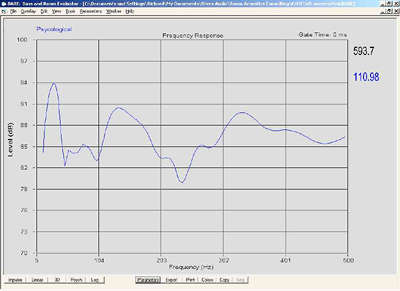
Fig.1 Rives PARC, uncorrected response of left channel from BARE. Peaks can be seen at 32.7Hz, 134Hz, and 340Hz.
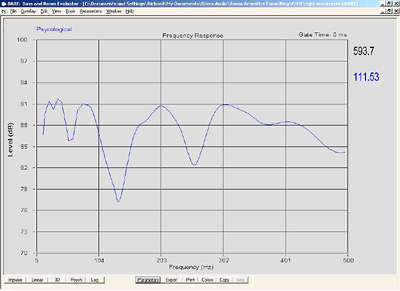
Fig.3 Rives PARC, uncorrected response of right channel from BARE. Two peaks can be seen flanking 35.3Hz and single peaks at 84.5Hz, 211Hz, and 302Hz.
Footnote 2: Since the PARC can only attenuate, not amplify, it can deal only with resonant peaks, not resonant nulls. Rives argues that this is a conservative and parsimonious approach that is less likely to lead to garish abuse than would ill-applied amplification. It can also be argued that the resonant modes will still store energy, even with attenuation, smearing the transient performance of the system, and that a comparable gain-correction of nulls is likely to have less of an effect on transient performance. Thus, aside from keeping us from abusing the PARC or exceeding power limits for the amp or speaker, I can think of no theoretical justification for not offering some null correction. Richard Bird tells me that the PARC hardware is capable of applying gain, but that the current software does not. They are considering a software modification to permit a small amount (up to 6dB) of gain.—Kalman Rubinson
NEXT: Page 3 »
Rives Audio PARC 3-Band Parametric Equalizer Page 3
| Channel | Frequency (Hz) | Q | Attenuation (dB) |
| L1 | 32.7 | 1.9 | 10.0 |
| L2 | 134 | 1.1 | 5.0 |
| L3 | 350 | 5 | 1.4 |
| R1 | 35.3 | 1.4 | 4.0 |
| R2 | 84.5 | 3.0 | 3.0 |
| R3 | 211 | 4.4 | 3.8 |
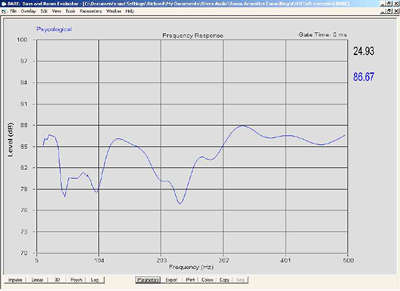
Fig.2 Rives PARC, corrected response of left channel from BARE. Note reduction in peaks and overall lowering of average bass levels.
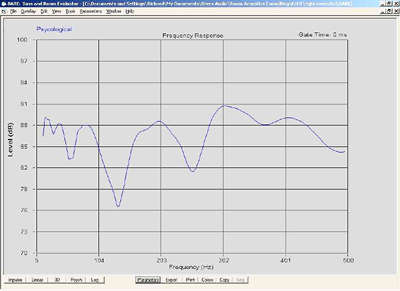
Fig.4 Rives PARC, corrected response of right channel from BARE. Note reduction in lower three peaks.
PARC Listening
With the PARC set to Bypass, its audible effect was vanishingly subtle. In either the recommended setup (between preamp and power amp) or the alternative setup (in the tape monitor loop), the difference between Bypass and straight-through with filters nulled was insignificant. In its active role, with filters set below 400Hz, the PARC was completely transparent in both the critical midrange and the revealing treble range. The high frequencies did seem a little brighter, in comparison with removing the PARC from the signal path, but this was probably the psychoacoustic concomitant of the improved, unmuddied bass. Way down, in the room-mode-vulnerable lower midrange and bass, the PARC was changing the sound, as was intended.
There were two ways to hear what the PARC did. First, I chose the deep male voices of Thomas Hampson and David Johansen (or any male WQXR announcer), and listened while switching the EQ in and out. With PARC EQ, the voice was always firmer, better defined harmonically and spatially, and easier to distinguish musically. Considering the corrections in the 200-350Hz range, this is not surprising.
To hear what the PARC did further down, I listened to Ray Brown's double bass on his classic Soular Energy album. The PARC maintained the powerful plucking with equal force and shape, despite attenuating rather than boosting any of the relevant frequencies. By fiddling with the controls, I found that the upper-bass corrections had a greater ameliorative effect than the lowest ones, even though the instrumental fundamentals were quite a bit lower. This is probably due to the ear's sensitivity dropping off at the very lowest frequencies and to the bass fiddle's harmonic richness.
One curious observation with Soular Energy was that the PARC corrections were both more effective and more appreciated with the analog signals from the DVD-Audio (HiRes HRM 2011) via the Meridian 800/861 DVD-Audio player, or the SACD (Groove Note GRV 1015-3) via the Sony XA-777ES SACD player, than from the LP (Pure Audiophile PA-002(2)). Pure Audiophile's blue vinyl discs are simply spectacular, with potent, taut bass at relatively higher levels than from the digital media, with or without PARC. One might chalk that up to the fact that the PARC correction was not customized to my particular combination of turntable, tonearm, cartridge, and phono stage, which, I'd venture, is not completely linear. With other, lesser LPs, the PARC wrought the same transformations as it had with the digital sources.
No questions have been asked about this item.
Ask the seller a public question
You must log in to ask a question.
Return Policy
Return Window
Returns are not accepted on this item.


